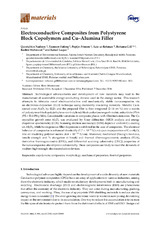Electroconductive Composites from Polystyrene Block Copolymers and Cu–Alumina Filler
Autor
Nadeem, QuratulAin
Fatima, Tasneem
Prinsen, Pepijn
Rehman, Aziz ur
Gill, Rohama
Mahmood, Rashid
Luque, Rafael
Editor
MDPIFecha
2016Materia
CopolymersComposites
Morphology
Mechanical properties
Thermal properties
METS:
Mostrar el registro METSPREMIS:
Mostrar el registro PREMISMetadatos
Mostrar el registro completo del ítemResumen
Technological advancements and development of new materials may lead to the manufacture of sustainable energy-conducting devices used in the energy sector. This research attempts to fabricate novel electroconductive and mechanically stable nanocomposites via an electroless deposition (ELD) technique using electrically insulating materials. Metallic Cu is coated onto Al2O3 by ELD, and the prepared filler is then integrated (2–14 wt %) into a matrix of polystyrene-block-poly(ethylene-ran-butylene)-block-polystyrene-graft-maleic anhydride (PS-b-(PE-r-B)-b-PS-g-MA). Considerable variations in composite phases with filler inclusion exist. The Cu crystallite growth onto Al2O3 was evaluated by X-ray diffraction (XRD) analysis and energy dispersive spectrometry (EDS). Scanning electron microscopy (SEM) depicts a uniform Cu coating on Al2O3, while homogeneous filler dispersion is exhibited in the case of composites. The electrical behavior of composites is enhanced drastically (7.7 × 10−5 S/cm) upon incorporation of Cu–Al2O3 into an insulating polymer matrix (4.4 × 10−16 S/cm). Moreover, mechanical (Young’s modulus, tensile strength and % elongation at break) and thermal (thermogravimetric analysis (TGA), derivative thermogravimetry (DTG), and differential scanning calorimetry (DSC)) properties of the nanocomposites also improve substantially. These composites are likely to meet the demands of modern high-strength electroconductive devices.

